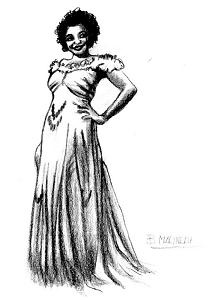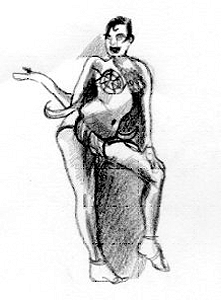
She was born in Chattanooga, Tennessee on 2nd June
1905, even if some biographical
sources give different dates, 1903, 1907.
She grew up in a musical family, which proved to be foundamental for for
her future artistic personality. Her mother Etta, an accomplished professional
musician, tutored Valaida on a variety of instruments: cello, bass, violin, banjo,
accordion, saxophone and trumpet. Like many artists of her time, eclettism was a
peculiar characteristic of her performances. She learnt to sing, dance and play
the trumpet so well that she became known as Little Louis.
 According
to Valaida her father was white and that seems to be borne out by her features,
which displayed the beauty typical of a mixed race. Her father had showbiz connections
and at an early age she was part of the vaudeville act "Snow's Gold Dust Twins".
According
to Valaida her father was white and that seems to be borne out by her features,
which displayed the beauty typical of a mixed race. Her father had showbiz connections
and at an early age she was part of the vaudeville act "Snow's Gold Dust Twins".
In 1922 she
was with Will Mastin's troupe for the revue "Holiday in Dixieland"
and later that year she worked in Barron Wilkin's popular Harlem cabaret.
The following year she was in the cast with the star Mamie Smith at the Lafayette
Theatre. In 1924 she
was featured in the Noble Sissle and Eubie Blake Chocolate Dandies
which toured for six months before opening on Broadway. Josephine Baker
and Lena Horne were in the choir.
It was a period of hard work, during which she polished her routine. Her
acquired experience and incoming fame, led her to an intensive tour in Europe and
the Far East. On the stage her brilliant performances included dancing, singing
and playing the trumpet.
She came back to the States in
1929.
The Great Depression of the
1930s had brought about
unemployment all over the country and the alternative to the economic system, in
big industrial cities was, in some cases, provided by gangsters who ran nightclubs.
Many jazz musicians and dancers were hired in jazz bands and better still if such
players provided services of several entertainers for the price of one, for example
singing and dancing as well as Valaida Snow. Chicago gave her the chance to work
with Earl Hines at the Sunset Café, where she recorded the song "Maybe
I'm to Blame". Soon after she appeared at the Apollo in Harlem.
 In
1930 she was on the
stage again, appearing in a black revue, co-starring with Ethel Waters in
Lew Leslie's Rhapsody in Black, but despite the important cast, including
the three Berry Brothers, the show did not have success. Valaida was persuaded
to quit, and this fact seems to be the cause of her attempt to commit suicide. In
the segregated Thirties Valaida's Snow's name was rarely out of the black newspapers,
for her music, as well for trouble that seemed to always follow her.
In
1930 she was on the
stage again, appearing in a black revue, co-starring with Ethel Waters in
Lew Leslie's Rhapsody in Black, but despite the important cast, including
the three Berry Brothers, the show did not have success. Valaida was persuaded
to quit, and this fact seems to be the cause of her attempt to commit suicide. In
the segregated Thirties Valaida's Snow's name was rarely out of the black newspapers,
for her music, as well for trouble that seemed to always follow her.
The 1930s
were the highlight of her career. Throughout the Thirties she was mainly active
in England, where she appeared in an updated version of the show "Blackbirds".
In 1936, accompanied
by the Six Swingers, Valaida recorded some of her most famous compositions
"High Hat", "Trumpet
and Rhythm", "I Want
A Lot Of Love", "Take
Care Of You For Me".
Coming back to America, she appeared in some Holliwood films around
1938, but it is Europe
again that wants her back. But Europe was now in turmoil for the incoming war. She
arrived in Paris in 1939
and the she headed north, finishing up in Denmark. Good friend Josephine Baker warned
Valaida to get out of Europe as fast as she could, but it was too late.
It was here in Europe that she lived tha most tragic experience in her
life. Returning to Denmark after a tour with her all girl orchestra in Sweden, she
was imprisoned by the occupying Nazis in Copenhagen and was subsequently placed
in a concentration camp, where she spent nearly two years (legend says that she
had been charged with drug possession and theft). After this period of captivity,
she was freed in a prisoner swap with the allied forces. She returned to New York
in 1942 and attempted
to put her life back in order again, but she was never the same again.
In the early Fifties she recorded
Tell me how long the train has been
gone, When a woman loves
a man, Porgy,
The more I know about love.

 The
afro-american writer Candace Allen, who has written a novel based on Valaida
Snow's life, admits that she found very little news about the artist. We do not
know anything about Valaida's childhood; that is why the book cannot be considered
a real biography, despite the rigorous research at the basis of the book. Here follows
what Candace Allen replies, when asked if the book was a source text for
Valaida's life: "There were huge holes in her life. As a historian or biographer
I could not have created a childhood for Valaida or amended her letters from prison.
I could only do that as a novelist".
The
afro-american writer Candace Allen, who has written a novel based on Valaida
Snow's life, admits that she found very little news about the artist. We do not
know anything about Valaida's childhood; that is why the book cannot be considered
a real biography, despite the rigorous research at the basis of the book. Here follows
what Candace Allen replies, when asked if the book was a source text for
Valaida's life: "There were huge holes in her life. As a historian or biographer
I could not have created a childhood for Valaida or amended her letters from prison.
I could only do that as a novelist".
If Josephine Baker was known for shocking people in Europe for
her trangression and freedom, Valaida shocked them in the USA, with her eccentric
behaviour. She travelled in an orchid coloured Mercedes, dressed in an orchid suit,
her per monkey rigged out in an orchid jacket and cap, with the chauffeur in orchid
as well.
She lived an intense life and enjoyed it, even if she bore the trouble
and and the tragic side that haunt many greats.She made the front page news for
her glorious endevours as well as for her downfalls.
Candace Allen described Valaida as a woman who "lived large, blazing
a trail with charismatic energy and inimitable style".
Her sentimental life was full of many failed love affairs. She had already
married once, when she met a very young popular dancer named Ananias Berry
(member of the Berry Brothers). He was 19 and she was in her early
30s when they got married.
His parents did everything to end the union, publicly shaming her when they found
she was married. Bigamy charges were made against her and she had to face in court.
She was found guilty, although she avoided imprisonment.
 Newspapers
reported some episodes of alcohol and drugs abuse, but she is also described as
the most glamorous black star of the time. According to an article in Storyville
by Derek Neville, she had an extraordinary good show-biz personality. He
wrote: "She had a very good voice and was a superb trumpet player, just a little
slip of girl, yet the volume of sound she could get out of a trumpet was fantastic,
she had a real Armstrong style".
Newspapers
reported some episodes of alcohol and drugs abuse, but she is also described as
the most glamorous black star of the time. According to an article in Storyville
by Derek Neville, she had an extraordinary good show-biz personality. He
wrote: "She had a very good voice and was a superb trumpet player, just a little
slip of girl, yet the volume of sound she could get out of a trumpet was fantastic,
she had a real Armstrong style".
Paradoxically it seems to have been her versatility that held her back.
Pianist Mary Lou Williams wrote about her: "She was hitting those high
C's just like Louis
Armstrong. She would have been a great trumpet player if she had dropped
the singing (and by implication the dancing) and concentrated on the trumpet".
Sometime after her repatriation, after the tragic experience in Europe,
she married producer Earle Edwards, and settled in New York. In the Fifties
she mostly appeared in the musical revues that have been Valaida's first love.
Her last performance was in May 1956.
She died of cerebral haemorrhage backstage at the Palace Theatre in New York.
Orchids in Snow: The Life and Music
Of Valaida Snow.
The Independent on line 16th January 2004: Candice Allen, Dance to the music of
fame.
Valaida Snow: Stranger than Fiction
Valaida Snow, an article by Barry McCanna
Women in jazz;
Valaida Snow: The Real Queen of Jazz.

